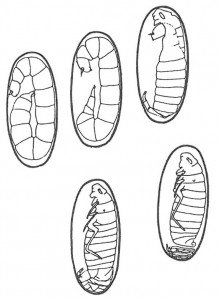
Flea eggs are smooth, oval and grayish-white. They are about 1/4 mm long and can barely be seen as small grains on a dark background.
The eggs are not glued to hair like nits, but sprinkles off the host animal, wherever it is. Flea larvae feed on various types of organic material, supplemented by the adult fleas’ bloody excrements. Flea larvae are blind and worm-like, and have bristles around each segment of the body. They are white, but the skin is transparent, so you can see the dark intestines. If flea larvae are disrupted, they roll up into a spiral shape and play dead for a moment. After four larval stages, the larvae have grown, and they pupate. They pupate in a cocoon of their own woven silk cocoon from the salivary glands. The cocoons are sticky, so they are usually covered in dust and dirt and are hard to spot. Inside the cocoon, the larva develops into an adult flea. After the transformation, the adult flea is ready to come out of the cocoon.
It can wait, though. If the cocoon is placed somewhere completely silent, it will stay inside the cocoon and it does not emerge from the cocoon until vibrations indicate that a host is near. The flea can wait that way for years. In houses that have been empty for a long time, the hungry fleas will hatch from their cocoons when new residents move in.




